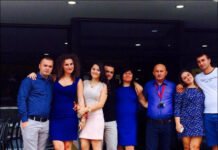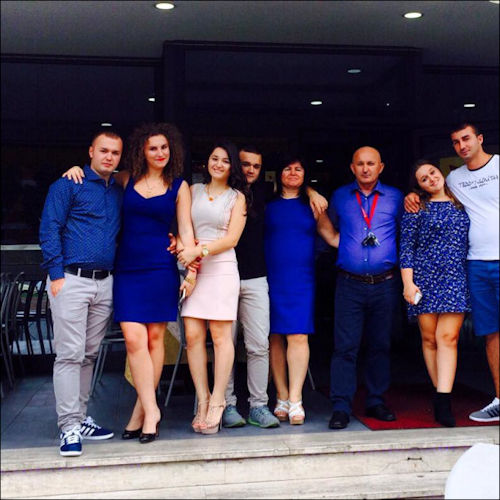 Albania is situated in the west shore of the Balkan Peninsula. It is a very small country, with only 3,5 million inhabitants, about 50 miles from Italy. In the early 1990’s, Albania ended 46 years of dictatorship and established a multiparty democracy. The transition has proven challenging. Successive governments have tried to deal with high unemployment, widespread corruption, a dilapidated physical infrastructure and powerful organized crime networks. Albania has old established connections with Italy, that has played a crucial role in the democratic strengthening of the country. Nowadays, although Albania’s economy continues to grow, the country is still one of the poorest in Europe.
Albania is situated in the west shore of the Balkan Peninsula. It is a very small country, with only 3,5 million inhabitants, about 50 miles from Italy. In the early 1990’s, Albania ended 46 years of dictatorship and established a multiparty democracy. The transition has proven challenging. Successive governments have tried to deal with high unemployment, widespread corruption, a dilapidated physical infrastructure and powerful organized crime networks. Albania has old established connections with Italy, that has played a crucial role in the democratic strengthening of the country. Nowadays, although Albania’s economy continues to grow, the country is still one of the poorest in Europe.
Italy, through the Cooperazione italiana allo sviluppo is present in Albania since 1991, to help the local government enhance the democratic and economic development1. Italy is the first trade partner and the third donor after the UE and the World Bank. In addition, numerous Italian NPO operate in order to strengthen education, local government, environment, agriculture and infrastructures 2.
————————–
1. Italian Embassy in Tirana, www.ambtirana.esteri.it
2. Italian Embassy in Tirana
3. CIA, The world fact book, Albania, www.cia.gov
According to the data from the School Office at Italian Embassy5 about 70% of the population can understand Italian language, and about 50% can speak it.
What makes the situation very peculiar, and probably unique, is that there has never been an Italian emigration to Albania. Instead, because of complex historical and geographical reasons, Albanians share the Italian language, as well as the Italian culture. In particular, in the northern region and especially in Shkoder, it is surprising to discover how many people of all ages can speak Italian. Actually, different languages are spoken, learned in different periods of the eventful Albanian history.


CIA, The world fact book, Albania, cit.
Elder people speak the language learned at school during the 1930’s. In that period, following an agreement between the Italian dictator Benito Mussolini and the Albanian King Zogu, studying Italian was compulsory in the public schools. In those times, Albania was a kind of Italian protectorate, a de facto if not de jure colony. However, the knowledge of the Italian language is much more ancient. As a matter of fact, the inheritance left by the Venetian Republic has had a deep impact on the Albanian culture.
————————–
5. Vito Antonio Stigliani, School Office Director, Italian Embassy in Tirana. Report 2009.
The Venetian Republic dominated Albania for only about 50 years, between the XIV and the XV centuries. However, although consequently dominated by the Ottoman Empire, Albania kept her traditional commercial relationships with Venice. In fact, the Ottomans granted a large autonomy to the country, in exchange for fidelity. Therefore, trade also helped keep alive the language and the culture of Venice. Many Venetian dialect words are still present in Gheg, the northern Albanian language. For example, the words pirun (fork), striga (witch), cariga (chair) ruga (street) give evidence of this.
Consequently, taking advantage of the weakening of the Ottoman Empire, in early 1900’s, Italy began a cultural and linguistic penetration. This, in competition with the Austro-Hungarian Empire, was supposed to be followed by military and economic control, facilitated by intelligence activity, weapons supply and help to the nationalist rebels. In fact, given its strategic position, Albania was considered a bridgehead for the control of the Balkan Peninsula and the Mediterranean Sea.
Starting in 1912, when Albania became independent, both Italy and Austria increased their presence. Italy founded schools, and helped pupils by giving books, scholarships, clothes and food. In addition, Italy encouraged the widespread of translated Italian books, postcards with Italian landscapes, and movies from Istituto Luce 6.
————————–
6. The Istituto Luce is the historic Italian film Institute, that was founded in 1924. It has a very rich archive.
Gradually, a strong connection was established between the catholic elites, particularly in the North, and the Italian culture. Through this connection, the Catholics wanted to claim the distance from the Ottoman religion and culture, which was deemed extraneous and oppressive. During the 1920’s and 1930’s, Italy’s hegemony, mainly focused on the economy, became more and more evident. Mine and oil well exploitation, and the creation of a protected marketplace for Italian goods, were the main aims. For these reasons, Italy began the construction of Albanian infrastructures like roads, bridges and ports, as well of military and civilian buildings like schools and hospitals.
In the whole, from 1925 until 1939 Italy invested in Albania 1,837,000,000 Lire. 7 This is a very considerable amount, if related to the Italian investments in the Balkans; it testifies that Albania was of crucial importance for Italy. 8 Mussolini even thought about an Italian farmers’ emigration, in order to develop the agriculture.
However, of the 2 millions who were supposed to go, only a few thousands farmers left for Albania. Moreover, there were military aims, as Albania was considered a strategic country for the expansion into the Balkan Peninsula. In 1939 Italy took direct control of the country and, following the military occupancy, King Vittorio Emanuele III was crowned King of Albania.
————————–
7. ATTI PARLAMENTARI, Discussioni, Discorso di Galeazzo Ciano alla Camera dei Fasci e delle Corporazioni, in LORENZO IASELLI, L’espansione economico-finanziaria italiana nei Balcani durante il fascism. Thesis.University of Naples, Departement of Economic History
8. But this economic effort was a failure: Albanians used most of the money received for trade with third countries. Morozzo Della Rocca, Roberto. 1997. Albania: le radici della crisi. Milano: Guerini.
In the same year, the Touring Club Italiano, an Italian association with the aim to promote tourism, published the Guida Rossa Albania 9. It was the first tourist guide on Albania, and it remained for decades the only one on the country. In the guide, exhaustive and very rich of information, travelers were alerted to the difficulties regarding street conditions and the lack of services. Nevertheless, it also described the country as fascinating and exotic. Moreover, it reassured tourists about the spread of the Italian language, which could facilitate the travel. During the 2nd World War, the relations between Italy and Albania were interrupted, as well as the construction of infrastructure.
Things changed radically after the war, when an atrocious dictator, Enver Hoxha, took power. He soon broke relations with the other communist countries, at first with the former Yugoslavia, then with the USSR, and at the end of the 1970’s also with the Republic of China, the only friendly country that remained. Since then, Hoxha refused any contact with other countries.
In Albania, a country very poor in raw material, infrastructures, industrial development, and with a backward agriculture, a rigid autarchy was established. Moreover, any kind of linguistic and cultural contact with abroad was strictly forbidden. Paradoxically, in this situation historical links with Italy were very lively. The extremely rigid control exerted by the dictatorship on any kind of communication, and the complete refusal of any contact with the outside world, not only failed
to weaken the Italian presence, but reinforced it.
————————–
9. A.A.V.V., Guida Rossa Albania, Touring Club Italiano, Milano 1939
Often, the only books which remained were Italian from the fascist period. Nowadays, some elder people speak a beautiful, cultured Italian learned from reading Italian books, which were sometimes their only solace during the long nights with candle light. Also, Italian books have been a solace for political prisoners, who often were punished for reading them. However, the most important aspect, and the one that probably has left a deeper footprint, has to do with Italian radio broadcasting.
During the 1960’s and 1970’s, people, hidden in the cornfields, listened to the Italian radio secretly.10 It was a very dangerous activity, that could be punished with years of jail. But those who were young in the 60’s did not want to give up with listening to the Festival di Sanremo 11, or Bandiera Gialla.12
————————–
10. Polovina, Ylli. 2002Rai e Albania. Una grande presenza nella storia di un popolo. Rome, RAI ERI, p. 111
11. The Festival della canzone italiana ( Italian song festival) is a very popular Italian song contest, running since 1951 and held every February in the city of Sanremo. 12. Bandiera Gialla was a groundbreaking radio broadcast, running from 1965 till 1970. Both the broadcasts were very popular and beloved in Italy and abroad. The title was particularly hated by the regime, as the flags could only be red. Polovina,Ylli, cit.,page 37
And nowadays, middle aged Albanians still remember very well, often better than Italians themselves, the songs, the stars and the programs of yore.
In this way, the Italian radio, and everything arrived through its broadcasts, became the only link with abroad, the only breath of fresh air in a society where everything was forbidden. This is why listening to those songs, and recalling them, has a much deeper meaning than entertainment; and this is why their memory is so precious. It has to do with freedom, a prohibited dream.
Those songs were the soundtrack for the young who only had a vague idea about was happening abroad. Through these songs, youth could imagine how the life could be, in a normal country only 50 miles away. In this way Italy, its culture, its language, became a myth for young Albanians. Therefore, Italian language has been much more than the language of a near country: it has been the language of a free country, of a rich and varied culture, the language of dreams.
From this point of view, television has had a minor and subsequently role, as they were very rare. On the other hand, Albanian television started to broadcast regularly only in 1971, and color television only in 1981. It could be that the lack of images helped Albanian youths to build their own imagery, deeper, more personal, and thus more deep-seated.
In the same years, the 1970’s, abroad and in particular in Marxist circles in Italy, people listened to Radio Tirana, which broadcasted in several languages, included Italian. They were dreaming of a country with uncontaminated shores, not corrupted by consumerism, where only 10 cars circulated and only in the capital.
Indeed, it was strictly forbidden to enter the country for almost anyone. Who traveled along the shores of the former Yugoslavia, once arrived at the border of Albania had to deviate inland. In this way, curiosity for a mysterious and inaccessible country increased, as did the charm of it. In Albania knowing Italian has always had a political and social connotation.
Nowadays, it is still the language of the catholic elite in the northern region, who in the past often felt excluded by the central power. This feeling was emphasized after 1972, when the Tosk, the language of the south region, became the official language of Albania, to the detriment of the Gheg, the northern language. As a result, nowadays it is still a sign of class distinction to speak Italian in a proper way; it points out a political and religious ethos.
Italian language and culture, here in its wider sense, is kept well alive also thanks to Albanian emigrants who, also because of the current recession, have gone back to their own country, bringing with them traditions from different Italian regions. An example of this is the Italian gastronomic tradition, recreated with much care in the numerous restaurants opened by Albanians.
Of course, nowadays Italian language is still studied, though no longer secretly thanks to the initiative of the Ministry of Foreign Affairs. The Illiria Program, with more than 25.000 students in middle school and high school, aims to spread the teaching of Italian as L2. In addition, there are three bilingual Italian-Albanian courses (from 1st to 4th year) at High School; and numerous Italian courses at University13.
————————–
13. Ambasciata d’Italia a Tirana, Cooperazione culturale, www.ambtirana.esteri.it
Pietro Marubi

Nowadays Albania is still considered a crucial country, although no longer for military reasons, but for political ones. This is testified by the traditional presence of France and Austria, especially in the cultural and linguistic fields. Most recently, Swiss and Spain have joined, and both are very active, with programs in support of the education and the local government. As said, there has never been an Italian emigration to Albania, apart from the 2000 farmers sent by Mussolini in 1939. But in different periods some Italians have gone to Albania, for various reasons.
 Albanian women
Albanian women
An example is Pietro Marubi, 14 a very active disciple of Garibaldi. Pietro Marubi (1834-1903) was an Italian painter and photographer who, around the year 1850, fled for political reasons from Piacenza, Italy, to Albania. He brought his cameras, and as an exile he settled in Shkoder where, in 1858, he opened the first photographic studio in the Balkans. He soon became very famous in the whole Peninsula through his pictures of family and landscape. Nowadays, the Fototeca Marubi in Shkoder is protected by UNESCO, and is rich with more than 250,000 negatives on film and plate glass.
————————–
14. www.shkoder.net
The most important Italian presence of the recent past in Albania, however, is connected with WWI and II.
As a matter of fact, about 35 wrecks of Italian war ships dating back to the at 1st and 2nd World
War lie deep in the Adriatic Sea in front of the Albanian shores. In July 2005 Italian divers found
————————–
15. With the kind permission of Arben Çokaj www.shkoder.net
16. With the kind permission of Arben Çokaj www.shkoder.net
the wreck of the Regina Margherita17. The battleship sank in 1916 during the 1st World War, probably because of a mine or a German torpedo, and almost 700 sailors died.
————————–
17. Corriere della Sera, August 17th 2005, Page 21
18. The New York Times, January 13th 1917
19. With the kind permission of Andrea Bolzoni, copyright IANTD
Part of the name REGINA M… on the stern of the wreck Regina Margherita Near the Regina Margherita lies the wreck of the Nave Ospedale Po, (Hospital Ship Po) which was hit by the Royal Navy Fleet Air Arm torpedo bombers on March 14th, 194120. The sinking of the ship was shocking because it was a regularly signaled hospital ship.

However, the most tragic page related to the Second World War has to do with the destiny of the Italian soldiers in Albania after September 8th 1943. On this date General Dwight Eisenhower and General Pietro Badoglio announced the Armistice. The Italian Army, with no comanders nor orders, dissolved in Italy and abroad. Soldiers didn’t know what to do. Many of them were taken prisoner by the Germans; many others became partisans and started to fight against the Germans with the Albanian partisans.
————————–
20. Supermarina, Comunicazione telefonica, March 15th, 1941, USMM, Ufficio Storico Marina Militare,
Roma
delle 18.30, trasmesso dai microfoni di, fu il discorso letto alle 19.42 dai microfoni dell’ da parte del, con il quale si annunciava l’entrata in vigore dell’ firmato con gli il giorno 3 dello stesso mese. At the Drejtoria e Përgjithshme e Arkivave in Tirana (Albanian State Archive), restored and reorganized with aid from the Italian Cooperation, many interesting documents are preserved.
 Italian soldiers in St. Gjin, Albania, after September 8th, 1943
Italian soldiers in St. Gjin, Albania, after September 8th, 1943
Some of them concern the minutes of the Circolo Garibaldi, an organization established in Tirana a few days after the Armistice between Italy and the Allied forces. The Circolo Garibaldi aimed to help the Italians who had remained in Albania as soldiers, workers or businessmen after September 8th, 1943.
Here is a passage from one of the minutes, dated January 13th, 1945
————————–
21. www.albanianews.it
“ Il numero degli italiani che vivono attualmente in Albania varia dai 25.000 ai 30.000. La maggior parte è costituita dagli ex militari che piuttosto di combattere assieme ai tedeschi , hanno preferito combattere a fianco dei Partigiani Albanesi contro gli occupatori, o la prigionia nei campi di concentramento. Questi ex soldati, sperando di poter raggiungerele loro case, scendono dalle montagne in condizioni deplorevoli: ammalati, denutriti, senza vestiti e senza scarpe.( …). L’altra parte è costituita da elementi civili. Anche per questi ultimi la situazione è veramente triste: le vessazioni, i soprusi, le brutalità subite dai nazisti e dai loro asserviti hanno gettato ogni famiglia nella miseria piú squallida. 22”
This passage is one of the several demands to the Albanian Governement to allow the return home of
children, women and sick people. In fact, at that moment Italy was considered an enemy country. The
minutes of the Circolo Gribaldi cover a period of about 2 years. The minutes tell the everyday difficultiesfor Italian soldiers and civilians, who often wee not able to find food or shelter. The minutes register heartbreaking accounts that often highlight the difficulty to find also very simple and essential things, like coffins.
But at the Drejtoria e Përgjithshme e Arkivave in Tirana there are also some letters of Italian soldiers,
or of families of Italian soldiers, who had remained in Albania as partisans or prisoners. These letters,
kept by the Circolo Garibaldi, have been mostly written by very simple people who found it hard to tell
their stories, and thus used sterotiped sentences to ask for the family’s news.
“Cari genitori, non voglio piú tralungare perché quando passa la cinsura ci vuole molto tempo. Con distinti saluti vi abbraccia forte forte a voi tutti il vostro affezionatissimo figlio Prigioniere Liberato Petrini”. 23
————————–
22. Tirana, Verbali Circolo Garibaldi, 1945, AQSHF.445, D53.
“At the moment there are about 25,000/30,000 Italians in Albania. Most of them are ex soldiers who didn’t want to go on fighting with Germans. So they have chosen to be on the side of Albanian partisans against the conquerors. , or to be prisoner in the Internment Camp. These ex soldiers, in the hope to be able to go home, walk down from the mountains in very poor conditions: sick, starving, without clothes and shoes. (…) But there are also some civilians, and for them the situation is very bad, too. They have received from the Germans any kind of violence and now they live in a sqaulid poverty.
But here are also more elaborated letters, where an evaluation on the political and military situation is
given, as in this letter of December 29th, 1944:
“Pochi giorni dopo l’aeroporto fu occupato dai Goti. Tradimento, tradimento in pieno, i nostri apparecchi
passavano nelle mani dei disumani Goti. A questa dolorosa nuova non potevo piú restare in quel campo
dove il comando dei Goti dettava legge. Mi nauseava la loro presenza e quindi decisi di andare dove gli
si combatteva, cioè in montagna. Grandi sono stati i sacrifici ma grandi sono state le soddisfazioni. Ho
sempre pensato a te e ho anche pensato di ritornare da te con amore. Ho fatto il mio dovere di italiano e
sono contento e soddisfatto.” 24

Enver Hoxha died in 1985, but only in March 1992 a decisive electoral victory was won by the opposition
led by the Democratic Party with Sali Berisha. The progress toward a democratic system was neither
easy nor linear. After almost 50 years of dictatorship the country efforts to establish a free-market
————————–
23. Tirana, Drejtoria e Përgjithshme e Arkivave, Lettere dei soldati italiani. AQSHF 656 D. 24/1
Fl. 33
“Dear parents, I can’t go on now, as it will take a long time to pass the censor. A big hug to everybody, your very devoted son, released prisoner Petrini”.
24. Tirana, Drejtoria e Përgjithshme e Arkivave, Lettere dei soldati italiani, AQSHF 656 D. 25 Fl.
125 “A few days later the Goths took the control of the airport. Treason, treason, our war plains were taken by the inhuman Goths. With this painful news I could no longer remain in that camp under the control of the Goths. I was nauseated by their presence and I decided to go where people fought against them, in the mountain. The sacrifices have been great, but the satisfaction as well. I always thought of you, and to come back to you with love. I have done my duty as an Italian citizen and I am happy and satisfied.”
economy met several difficulties, but also opened the road for Albania to obtain vast amounts of aid
from European countries. Among these countries, Italy played a crucial role, and it is now the first trade partner with Albania. The historic, linguistic, cultural and economic connections are so strong that a new definition has been coined by an important Italian newspaper: ”Albania, 21esima regione italiana”25. An italian scholar, Morozzo Della Rocca, has used this definition as well in a study on the Albanian crises of 1990’s 26.

In both cases this definition is of course not referred to any kind of conquest like in 1939. It wants to underline the close connections between the two countries, and the role, not only economic, that Italy can play in the Albanian developement. “L’Italia è il paese di riferimento per gli albanesi. L’Italia è la dolce vita, la moda, il mangiare bene, la Fiat e la Ferrari, il Mulino Bianco e la Benetton” 27.
And through this all, and much more, Albanians go on feeding their Italian dream and the imagery
connected with it.
————————–
25. Orizio, Riccardo. 1992, November 11. Sul trono di Tirana. Corrier della Sera, page 28. Albania, 21st Italian region
26. Morozzo Della Rocca, Roberto. 1997. Albania:; le radici della crisi. Milano: Guerini.
27. Morozzo Della Rocca, cit., page 44. Italy is the reference country for Albanians. Italy is the dolce vita, fashion, good food, Fiat and Ferrari, Mulino Bianco and Benetton.
Bibliography
A.A.V.V. 2002. Albania questa sconosciuta. Roma: Editori Riuniti
.A.V.V., 1939. Guida Rossa Albania., Touring Club Italiano, Milano 1939
A.A.V.V. 1975. La Resistenza italiana. Verona: Mondadori.
Bartolini, Alfonso. 1986. “Per la patria e la liberta’”. I soldati italiani nella Resistenza all’estero. Milano: Mursia.
Brunetti, Bruno. S.D. Da oppressori a combattenti per la liberta’: gli italiani della Divisione Antonio Gramsci nella lotta di liberazione del popolo Albanese. Istituo Storico della Resistenza. Lucca: Fondo Toce Albania.
Biagini, Antonello. 1998.Storia dell’Albania contemporanea. Milano: Bompiani
Carocci, Giampiero. 1969. La politica estera dell’Italia fascista (1925-1928), Bari: Laterza.
Morozzo della Rocca, Roberto. 1997. Albania: le radici della crisi. Milano: Guerini.
Kadare’, Ismail. 2004 . Il generale dell’armata morta. Milano: Corbaccio.
Polovina, Ylli. 2002. RAI e Albania: una grande presenza nella storia di un popolo. Translation by Besiana Polovina. Roma: RAI ERI
Roselli, Alessandro. 1986. Italia e Albania. Relazioni finanziarie nel ventennio fascista. Bologna: Il Mulino.
Serra, Alessandro. 1974. Albania 8 settembre ’43 – 9 marzo ’44. Milano: Longanesi.
USRM, 1938. La Marina italiana nella grande Guerra, vol III. Firenze: Vallecchi
Salleo, Ferdinando. 2000. Albania: un regno per 6 mesi. Palermo: Sellerio


Web Sites
www.ambtirana.esteri.it
www.anpi.it
www.cia.org
www.corriere.it
www.iantdexpeditions.com
www.luce.it
www.nytimes.com
www.osservatoriobalcani.it
www.shkoder.net
Albanian State Archive:
Tirana, Drejtoria e Përgjithshme e Arkivave
Rruga “Jordan Misja” Tiranë, Shqipëri
Appendix
1) Letter from released prisoner Petrini. Tirana,1945. Drejtoria e Përgjithshme e
Arkivave, Lettere dei soldati italiani . AQSHF 656 D. 24/1 Fl. 33
2) Minute of Circolo Garibaldi. 1954. Tirana, Drejtoria e Përgjithshme e Arkivave,
Lettere dei soldati italiani, AQSHF 656 D. 25 Fl. 125
3) The New York Times, January 13th 1917
4) The New York Times, January 13th 1917
5) Supermarina, Comunicazione telefonica, March 15th , 1941, USMM, Ufficio Storico
Marina Militare, Roma
6) Supermarina, Comunicazione telefonica, March 15th, 1941, USMM, Ufficio Storico
Marina Militare, Roma









